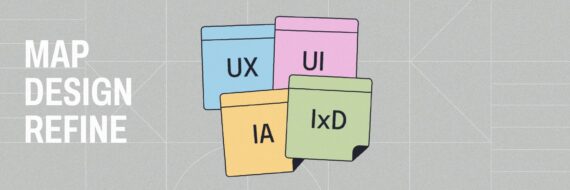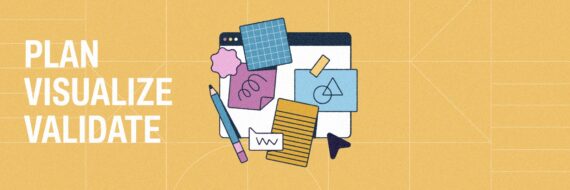This topic is so hotly debated you could cook an egg on this article. UX strategy vs product strategy. Here we go… We’re going to just have to rip the Band-Aid off and go for it but we may not be writing the very typical answers to some of these questions. This doesn’t mean everybody else is wrong, it just means we’re giving you a different way to look at it. There will be no product design strategies, just the straightforward views on the topics at hand.
Are product strategy and UX strategy the same thing?
No. But they are part of the same system with respect to your business strategy and business plan.
To more concretely answer this long argued question, we need some definitions.
Your product strategy is the roadmap that’s used to develop your product or feature. It includes all of the tasks that your team needs to complete to achieve your business goals.
UX strategy – but if we apply the same principles as the above definition, it defines what the UX should be achieving in how it makes the customer feel while using the product and how it’s brought to life through a UX product roadmap or planning process which is intertwined with how it improves on the product itself, again, for the customer.
Get it? Got it? Good.
With that being said, some folks will tell you that UX strategy doesn’t exist. What a load of hooey. In that case, we’ve wasted a lot of time writing blogs and creating a UX-intensive product for you here. It does exist. To say they’re not their own “things” is a bit shallow in thought. A statue inside of a building is its own “thing” but the statue is part of the design of that building. Not only does it exist, UX design can further be defined and is important to know.
It’s not just good luck that leads to a compelling product, it’s the interplay between product and UX strategy and getting it right means developing a deep understanding of how the two effectively play together.
🎬 Learn what Slickplan can do!
We filmed a short video to show you exactly how to use Slickplan
UX strategy vs product strategy comparison: what’s the difference?
The difference between product and UX strategy is difficult to pin down because UX strategy is so deeply a part of product strategy and as such can be tricky. Product strategy focuses on business elements and the broad strokes of the product and its function. UX strategy focuses on the customer and how they interact with and feel while using the product. Similar goals; vastly different MOs.
Product strategists go over things from a business perspective. They look for areas in the market that need to be served because there isn’t a product or are underserved with the existing products on the market. This can include field studies, competitive analysis and market research. These strategists also look into existing products and ways to improve them including how to make production cheaper, and hopefully more cost-efficient for the end-user. To that end, working directly with stakeholders isn’t uncommon.
They must have “the vision”. What we mean by that is the vision to take a product and run with it, to get the very most out of it in terms of revenue, cost efficiency and customer satisfaction, typically year-over-year. UX strategists, on the other hand, are very user-centric – they should be anyhow. These are product testing junkies with a passion for taking what’s there and making it even better for the user. They’re finding ways to improve the way you feel when you use their product. A UX strategist wears many hats in the development and betterment of a product and sometimes they’ve got to stack all the hats on at the same time to get the job done. A balancing act that pays off through the success of the product they’ve put solid work into.

Now, they aren’t just going about this all willy nilly. They’re using user personas, focus and test groups, market data, research and more to sharpen the user experience. This is data-driven work that starts at the initial conception of the product or service and with the goal of constant improvement . They need to be able to do this in tandem with the product strategist who is also providing valuable information to the process. This all needs to happen while keeping sacred the business model and the shared task of competitive analysis. Everybody should stay abreast of the competition. This includes using the best of the best UX design tools.
Something to keep in mind about the table below, because user experience product development or design strategy is part of product strategy, technically, the entire table applies to both. However, we’re going to give examples that tend to have a more clear either/or differentiation. Even though something may be UX-based, it’s still in the product strategy family but with its own set of rules and standards.
Both parties will be looking at a lot of the same data, like; product vision, target users, focus groups and a ton more. Product success is quite literally tied to how well these parties work together to increase market share and customer retention through various iterations of the product. Anything less will lack the depth of insight that generally leads to a successful product.
| Comparison | Product or UX strategy? |
|---|---|
| Business Models | Product Strategy |
| Customer Acquisition | Product Strategy |
| Competitive Advantage | Both |
| Interaction Design | UX Strategy |
| Value Innovation | Both |
1. Business models
If we take into account the discussed definitions of the two categories, this one squarely falls into the product strategy lane. How well your product does in the marketplace is directly tied to your business model. A business model, in short, describes how you create and deliver value in a product for customers. User experience design in this aspect would come into play when it comes to how the customer feels about the product and their interaction with it. You may read that business strategy and UX strategy are tied together, which they are, but for this example, the business model is ever-so-slightly different in scope. Model refers to the logic behind the choice and strategy refers to choosing that model.
2. Customer acquisition
Acquiring customers falls squarely in the lap of your business model and thus in the hands of the product strategy. Once you have the customers, the UX strategy should be what keeps them around. It’s as simple as that.
3. Competitive advantage
Competitive advantage is equal parts UX and product strategy and this could arguably be said for physical products as well as digital products. Why should I buy your product? What’s it going to do or solve for me that improves my life going forward? That’s product strategy.
What’s going to make me really happy that I chose your product over your competitor? That’s UX design. Differentiation should be obvious to me as the user. UX researchers put a lot of time and effort into making damn sure that a product is a notch above the competition. Well that’s the goal anyway but given that every UX designer at every company is striving for the same, differentiation is tough, the competition is fierce and it’s why the best UX designers come with a high price tag.
Keep in mind, both parties should be looking deep into this one. You need to have a competitive edge and you need to know what other people are doing. Keep it legal though and avoid those corporate espionage charges, ya know, play fair but work hard to understand what’s out there and then find a way to do it better. Be that annoying one-upping friend everybody loves to hate. Just not with your coworkers.
4. Interaction design
Flat out, interaction design, also known as IxD, is a UX design task. Various research methods will provide best practices for what to use, where to use it and when as well as what works best for each type of user. This is very much a cornerstone of UX design (group studies, user personas, industry standards, etc.) Typically interaction design will be website and app focus like what happens when my mouse lands on that box, or if I scroll what all happens? A real world example could be something as simple as when I turn off my home stereo, does the red light around the power button turn on or off?
If you need additional clarity on the IxD vs UX distinction, our glossary has definitions to help you out.
5. Value innovation
This is all hands on deck. Value innovation is the convergence of improving the design and function of a product while lowering the cost – for both maker and end-user. Team members from both parties have good reason to always hold this one close to the heart as it means keeping your job. No product=no job. If we were still using the original iPhone, Apple wouldn’t be where it is today. As great as MacBooks are, it wouldn’t have been enough to make them a trillion-dollar company.
The UX strategist vs product manager: Can they work in harmony?
Similar to getting designers and developers working together, however challenging, to answer the question for both cases – the short and polite answer here is "they sure as heck better". If they’re not, you have a behemoth of a problem on your hands which makes your product’s chances of success pretty slim. That’s the reality of the situation here.

A few reasons why this can be a problem
- You may have a product that could be successful but you wasted it away on a team that couldn’t work together or didn’t know how to.
- You may give up on the product because of the above.
- You may go through iterations of the product and make assumptions that are not true, which have nothing to do with the product but instead should’ve been about your team.
Slickplan is in a unique position to assist in this process. As a website planning suite (and then some) we offer tools to keep the process streamlined. We’ve held dear the four tenets of UX design to bring you an unparalleled experience to build your best work. The four tenets are business strategy, value innovation, validated user research, and killer UX design. All of them are extremely important.
How can UX design strategy influence product strategy?
If your UX strategy isn’t influencing your product strategy – you’re kinda, sorta doing it wrong. Doing your due diligence with user research should get you to that conclusion if your stakeholders haven’t already. Your product team should absolutely be listening to the UX team and creating a well-oiled feedback loop. The product is influenced by how well it does on the market and collaboration between the two is vital in the process of getting it right. The product development process gathers those insights from many sources.
Think visually. Improve UX with Slickplan
Build intuitive user flows, stronger customer journeys and improve information architecture.
Key takeaways
What we hope you take away from this is that UX strategy and product strategy have a complementary relationship with UX strategy being part of the broader product strategy. They, therefore, work very closely together and shouldn’t be taken as mutually exclusive. It’s easy to make the mistake of viewing them as the same thing which can quickly and erroneously have you overlooking key needs for the success of your product. Whatever your endeavor though, remember why you started in the first place; to solve a problem and/or leave your end-user better off than they were before. UX strategy and product strategy are integrally involved in getting you to that promised land of success.







 X
X

